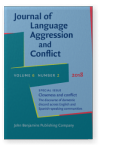Introduction
Closeness and conflict
This article is available free of charge.
References (45)
References
Arcidiacono, Francesco, and Antonio Bova. 2017. Interpersonal Argumentation in Educational and Professional Contexts. Springer: New York. 

Attardo, Salvatore. 2000. “Irony as Relevant Inappropriateness.” Journal of Pragmatics 321: 793–826. 

Bou-Franch, Patricia, Garcés-Conejos Blitvich, Pilar. 2014. “Conflict Management in Massive Polylogues: A Case Study from YouTube.” Journal of Pragmatics 731: 19–36. 

Boxer, Diana. 1993. “Social Distance and Speech Behavior: The Case of Indirect Complaints.” Journal of Pragmatics 191: 103–25. 

Bravo, Diana. 1999. “¿Imagen ‘positiva’ vs imagen ‘negativa’?: Pragmática sociocultural y componentes de face
.” Oralia 21: 155–84.
Brenes Peña, Ester. 2011. Tertulia televisiva y descortesía verbal. Análisis pragmalingüístico. Berne: Peter Lang. 

Brown, David. 2000. “Educational Beliefs: An Overview.” In Interactive Learning: Vignettes from America’s Most Wired Campuses, edited by David Brown, 3–7. Boston: Anker.
Cloke, Kenneth and Joan Goldsmith. 2011. Resolving Conflicts at Work: Ten Strategies for Everyone on the Job. San Francisco: Jossey-Bass.
Fant, Lars. 1989. “Cultural Mismatch in Conversation: Spanish and Scandinavian Communicative Behaviour in Negotiation Settings.” Hermes Journal of Linguistics 31: 247–65.
Fuentes Rodríguez, Catalina, and Esperanza Alcaide Lara. 2008. (Des)cortesía, agresividad y violencia verbal en la sociedad actual. Sevilla: Universidad Internacional de Andalucía.
Fuentes Rodríguez, Catalina, and Esperanza Alcaide Lara. 2009. Manifestaciones textuales de la descortesía y agresividad verbal en diversos ámbitos comunicativos. Sevilla: Universidad Internacional de Andalucía.
Fuentes Rodríguez, Catalina, and María Elena Placencia. 2013. “Polémica y/o descortesía en programas televisivos de crónica social en Ecuador y España: El caso de Vamos con todo y Sálvame diario.” In (Des)cortesía para el espectáculo: estudios de pragmática variacionista, edited by Catalina Fuentes Rodríguez, 127–65. Madrid: Arco/Libros.
García-Gómez, Antonio. 2012. “Perceptions of Assertiveness among Women: Triggering and Managing Conflict in Reality Television.” Discourse & Communication 6 (4): 379–399. 

González, Marina. 2010. “Las funciones del insulto en debates políticos televisados.” Discurso & Sociedad 41: 828–52.
Goodwin, Marjorie H. 1982. “Processes of Dispute Management among Urban Black Children.” American Ethnologist 91: 76–96. 

Grimshaw, Allen. 1990. Conflict Talk: Sociolinguistic Investigations of Arguments in Conversations. Cambridge: Cambridge University Press.
Häggkvist, Cilla, and Lars Fant. 2000. “El intercambio de opiniones en conversaciones intra e interculturales.” Oralia 31: 95–111.
Hernández Flores, Nieves. 2002. La cortesía en la conversación española de familiares y amigos: la búsqueda del equilibrio entre la imagen del hablante y la imagen del destinatario. Aalborg: Institut for Sprog og Internationale Kurturstudier, Aalborg Universitet, Vol 371.
Lorenzo-Dus, Nuria. 2007. “(Im)Politeness and the Spanish Media: The Case of Audience Participation Debates.” In Research on Politeness in the Spanish-speaking World, edited by María Elena Placencia and Carmen García, 145–66. Mahwah, N.J: Lawrence Erlbaum.
Lorenzo-Dus, Nuria. 2008. “Real Disorder in the Court: An Investigation of Conflict Talk in US Television Courtroom Shows.” Media, Culture & Society 30 (1): 81–107. 

Lorenzo-Dus, Nuria. 2009. Television Discourse: Analysing Language in the Media. Basingstoke: Palgrave Macmillan. 

Lorenzo-Dus, Nuria, Pilar Garcés-Conejos Blitvich, and Patricia Bou-Franch. 2011. “On-line Polylogues and Impoliteness: The Case of Postings Sent in Response to the Obama Reggaeton YouTube Video.” Journal of Pragmatics 431: 2578–93. 

Mancera Rueda, Ana, and Ana Pano Alamán. 2013. El discurso político en Twitter. Anthropos: Barcelona.
Maynard, Douglas W. 1985. How children start arguments Language in Society, 14 (1): 1–29.
Norrick, Neal R., and Alice Spitz. 2008. Humor as a resource for mitigating conflict in interaction. Journal of Pragmatics, 40 (10): 1661–1686.
Padilla García, Xose A., and María Belén Alvarado Ortega. 2010. “Being Polite through Irony.” In Dialogue in Spanish: Studies in Functions and Contexts, edited by Koike, Dale and Lidia Rodríguez-Alfano, 69–87. Amsterdam/Philadelphia: John Benjamins. 

Papke, Edgar. 2016. The Elephant in the Boardroom: How Leaders Use and Manage Conflict to Reach Greater Levels of Success. Wayne, N. J.: The Career Press.
Pexman, Penny M., and Kara M. Olineck. 2002. “Does Sarcasm Always Sting? Investigating the Impact of Ironic Insults and Ironic Compliments.” Discourse Processes 33 (3): 199–217. 

Placencia, María Elena. 2008. “(Non)Compliance with Directives among Family and Friends: Responding to Social Pressure and Individual Wants.” Intercultural Pragmatics 5 (3): 315–44. 

Placencia, María Elena. 2011. La insistencia entre familiares y amigos en el español quiteño: ¿de la interconexión hacia la autonomía? In Estudios de variación pragmática en español, edited by Carmen García and María Elena Placencia, 185–214. Buenos Aires: Dunken.
Placencia, María Elena, and Ana Mancera Rueda. 2011. “
Vaya, ¡qué chungo! Rapport-building Talk in Service Encounters: The Case of Bars in Seville at Breakfast Time.” In Spanish at Work: Analysing Institutional Discourse across the Spanish-speaking World, edited by Nuria Lorenzo-Dus, 192–207. Basingstoke: Palgrave Macmillan. 

Rühlemann, Christoph. 2010. “What Can a Corpus Tell us about Pragmatics?” In The Routledge Handbook of Corpus Linguistics, edited by Anne O’Keeffe, and Michael McCarthy, 288–301. London: Routledge. 

Schiffrin, Deborah. 1984. “Jewish Argument as Sociability.” Language in Society 13 (3): 311–335. 

Schiffrin, Deborah. 1985. “Everyday Argument: The Organization of Diversity in Talk.” In Handbook of Discourse Analysis, edited by Teun A. van Dijk, 35–46. London: Academic Press.
Scott, Vivian. 2015. Workplace Conflict Resolution Essentials. Queensland: Wiley Australia.
Sheldon, Amy. 1990. “Pickle Fights: Gendered Talk in Pre-school Disputes.” Discourse Processes 13 (1): 5–31. 

Tannen, Deborah. 1998. The Argument Culture. Stopping America’s War of Words. New York: The Random House Publishing Group.
Thurén, Britt-Marie. 1988. Left Hand Left Behind: The Changing Gender System of a Barrio in Valencia, Spain. Stockholm Studies in Social Anthropology, 22. Stockholm: University of Stockholm.
Wolfson, Nessa. 1981. “Compliments in Cross-cultural Perspective.” TESOL Quarterly 151: 117–24. 

Wolfson, Nessa. 1983. “An Empirically Based Analysis of Complimenting in American English.” In Sociolinguistics and Language Acquisition, edited by Nessa Wolfson and Elliot Judd, 82–95. Rowley, MASS: Newbury House.
Wolfson, Nessa. 1988. “The Bulge: A Theory of Speech Behavior and Social Distance.” In Second Language Discourse: A Textbook of Current Research, edited by Jonathan Fine, 21–38. Norwood, NJ: Ablex.
Cited by (1)
Cited by one other publication
This list is based on CrossRef data as of 5 july 2024. Please note that it may not be complete. Sources presented here have been supplied by the respective publishers.
Any errors therein should be reported to them.
